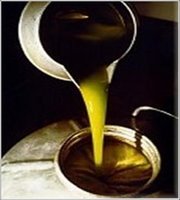The olives is a significant step for the realization of a quality product, but not the only important factor. Before and after the pressing may in fact be put in place a number of useful devices to promote and preserve the creation of a quality product.
- OLIVES
- The Cultivar: represents the starting point for the differentiation of Oil. Knowing the characteristics of each variety allows us to adapt the subsequent phases of the product we want to achieve

- State of health: The olives must be healthy, free of chemical residues and harvested from the plant (before the fall to the ground).
- Harvest: depends on the cultivar, the area cultivation and the year. However, it appears unique start collecting from the earliest cultivar (in the order Leccino, Maurino, Moraiolo, Frantoio, correct it for the main Tuscan cultivars) when the drupes show skin partially or completely dark. It is recalled olives tend to be overripe provide a product low in aromatics and a low resistance to oxidation. During fruit ripening, emerging as the level of free acidity, total polyphenols decreased gradually. The olives provide the right degree of ripeness, however, a more harmonious and balanced oil, and high resistance to oxidation.
- CONSERVATION OF THE OLIVE
- On Golf: The olives harvested in the field must be deposited in boxes low (20-30 cm) of plastic or wood, large windows and easily stackable.
- In Firm: small boxes can also be used for storage in a company, or olives can be transferred into large perforated caissons (bins) available from the Social Frantoio, which ensure good ventilation during the stock in the mill.
Olives in storage in the field, farm or during transport to the mill should not be stored in jute bags or plastic. Good aeration olives at this stage makes it possible to prevent the onset of fermentation and oxidation that adversely affect the oil quality. It 'also important not to spend a little longer than 2-3 days between harvesting and crushing.
After crushing
The Conservation of 'oil must be handled with care, an oil well preserved, in fact, can keep for a long time its organoleptic, chemical and physical properties.
to be stable over time, extra virgin olive oil should be preserved from the main sources of decay, such as light, heat and oxygen.
- container - Cleanliness is the first requirement to preserve and conserve oil. The container should then be easily cleaned and do not have unpleasant odors that may be absorbed by the oil.
E 'therefore important to avoid washing the container with scented detergent or vinegar, to be preferred instead of hot water and rinse thoroughly. The oil has
photolabile components must be kept away from light, even indirect, in dark containers.
The cover must provide isolation from the air and the bottom for easy removal of solid residues which tend to settle with time (bottom tilted with valve). - storage location - oil has the ability to absorb odors from the environment that surrounds it, so it is recommended to avoid strong odors which are characterized by
(places of storage of fuel or chemicals, or with the presence of mold).
The temperature is a critical parameter for the proper conservation of oil, this should range between 10 and 24 ° C, with optimum values \u200b\u200bfrom 14 to 18 ° C. - The Filtration - The oil can be filtered within 15-20 days of production in order to remove the products from crude from waste wood or fruit. There are several possible levels of filtering associated with a greater clarity of the product. Not to be forgotten that the high purity can lead to an increased oxidation. Unfiltered oils must be subject to periodic removal of the fund.
 OLIVES
OLIVES
- State health
- Harvest
- conservatives and Company
OIL
- Clean Place the container storage
- Local temperature of the storage
for "quality oil" means oil with a chemical-physical and organoleptic high, characterized by a long-term stability and by 'the absence of contaminants (pesticides, pesticides, etc. ..).